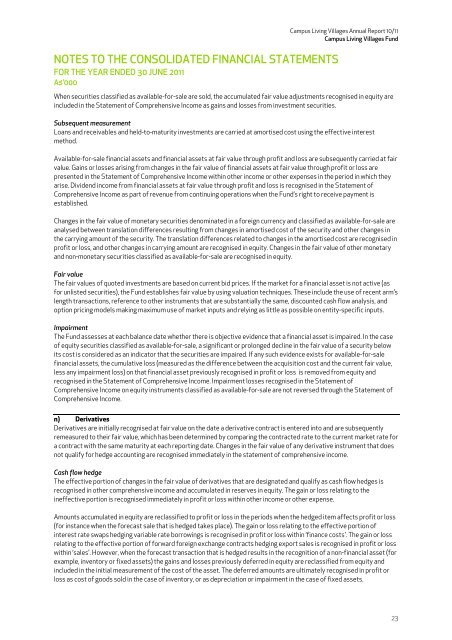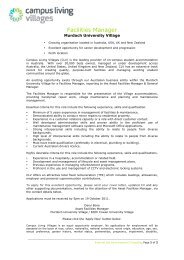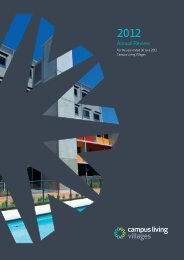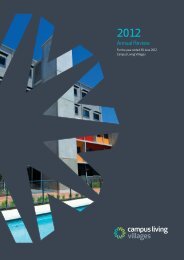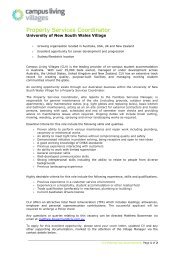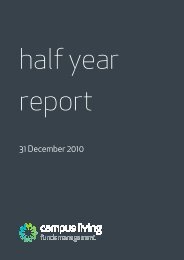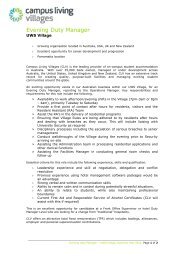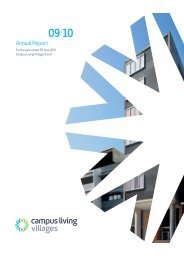Annual Report 10/11 - Campus Living Villages
Annual Report 10/11 - Campus Living Villages
Annual Report 10/11 - Campus Living Villages
Create successful ePaper yourself
Turn your PDF publications into a flip-book with our unique Google optimized e-Paper software.
NOTES TO THE CONSOLIDATED FINANCIAL STATEMENTS<br />
FOR THE YEAR ENDED 30 JUNE 20<strong>11</strong><br />
A$’000<br />
<strong>Campus</strong> <strong>Living</strong> <strong>Villages</strong> <strong>Annual</strong> <strong>Report</strong> <strong>10</strong>/<strong>11</strong><br />
<strong>Campus</strong> <strong>Living</strong> <strong>Villages</strong> Fund<br />
When securities classified as available-for-sale are sold, the accumulated fair value adjustments recognised in equity are<br />
included in the Statement of Comprehensive Income as gains and losses from investment securities.<br />
Subsequent measurement<br />
Loans and receivables and held-to-maturity investments are carried at amortised cost using the effective interest<br />
method.<br />
Available-for-sale financial assets and financial assets at fair value through profit and loss are subsequently carried at fair<br />
value. Gains or losses arising from changes in the fair value of financial assets at fair value through profit or loss are<br />
presented in the Statement of Comprehensive Income within other income or other expenses in the period in which they<br />
arise. Dividend income from financial assets at fair value through profit and loss is recognised in the Statement of<br />
Comprehensive Income as part of revenue from continuing operations when the Fund’s right to receive payment is<br />
established.<br />
Changes in the fair value of monetary securities denominated in a foreign currency and classified as available-for-sale are<br />
analysed between translation differences resulting from changes in amortised cost of the security and other changes in<br />
the carrying amount of the security. The translation differences related to changes in the amortised cost are recognised in<br />
profit or loss, and other changes in carrying amount are recognised in equity. Changes in the fair value of other monetary<br />
and non-monetary securities classified as available-for-sale are recognised in equity.<br />
Fair value<br />
The fair values of quoted investments are based on current bid prices. If the market for a financial asset is not active (as<br />
for unlisted securities), the Fund establishes fair value by using valuation techniques. These include the use of recent arm’s<br />
length transactions, reference to other instruments that are substantially the same, discounted cash flow analysis, and<br />
option pricing models making maximum use of market inputs and relying as little as possible on entity-specific inputs.<br />
Impairment<br />
The Fund assesses at each balance date whether there is objective evidence that a financial asset is impaired. In the case<br />
of equity securities classified as available-for-sale, a significant or prolonged decline in the fair value of a security below<br />
its cost is considered as an indicator that the securities are impaired. If any such evidence exists for available-for-sale<br />
financial assets, the cumulative loss (measured as the difference between the acquisition cost and the current fair value,<br />
less any impairment loss) on that financial asset previously recognised in profit or loss is removed from equity and<br />
recognised in the Statement of Comprehensive Income. Impairment losses recognised in the Statement of<br />
Comprehensive Income on equity instruments classified as available-for-sale are not reversed through the Statement of<br />
Comprehensive Income.<br />
n) Derivatives<br />
Derivatives are initially recognised at fair value on the date a derivative contract is entered into and are subsequently<br />
remeasured to their fair value, which has been determined by comparing the contracted rate to the current market rate for<br />
a contract with the same maturity at each reporting date. Changes in the fair value of any derivative instrument that does<br />
not qualify for hedge accounting are recognised immediately in the statement of comprehensive income.<br />
Cash flow hedge<br />
The effective portion of changes in the fair value of derivatives that are designated and qualify as cash flow hedges is<br />
recognised in other comprehensive income and accumulated in reserves in equity. The gain or loss relating to the<br />
ineffective portion is recognised immediately in profit or loss within other income or other expense.<br />
Amounts accumulated in equity are reclassified to profit or loss in the periods when the hedged item affects profit or loss<br />
(for instance when the forecast sale that is hedged takes place). The gain or loss relating to the effective portion of<br />
interest rate swaps hedging variable rate borrowings is recognised in profit or loss within ‘finance costs'. The gain or loss<br />
relating to the effective portion of forward foreign exchange contracts hedging export sales is recognised in profit or loss<br />
within ‘sales'. However, when the forecast transaction that is hedged results in the recognition of a non-financial asset (for<br />
example, inventory or fixed assets) the gains and losses previously deferred in equity are reclassified from equity and<br />
included in the initial measurement of the cost of the asset. The deferred amounts are ultimately recognised in profit or<br />
loss as cost of goods sold in the case of inventory, or as depreciation or impairment in the case of fixed assets.<br />
23


